This interview is part of a series of interviews with European craftspeople conducted in collaboration between FRH, the European network for religious heritage, and Mad’in Europe, the network of European fine and traditional crafts and cultural heritage restoration professions.
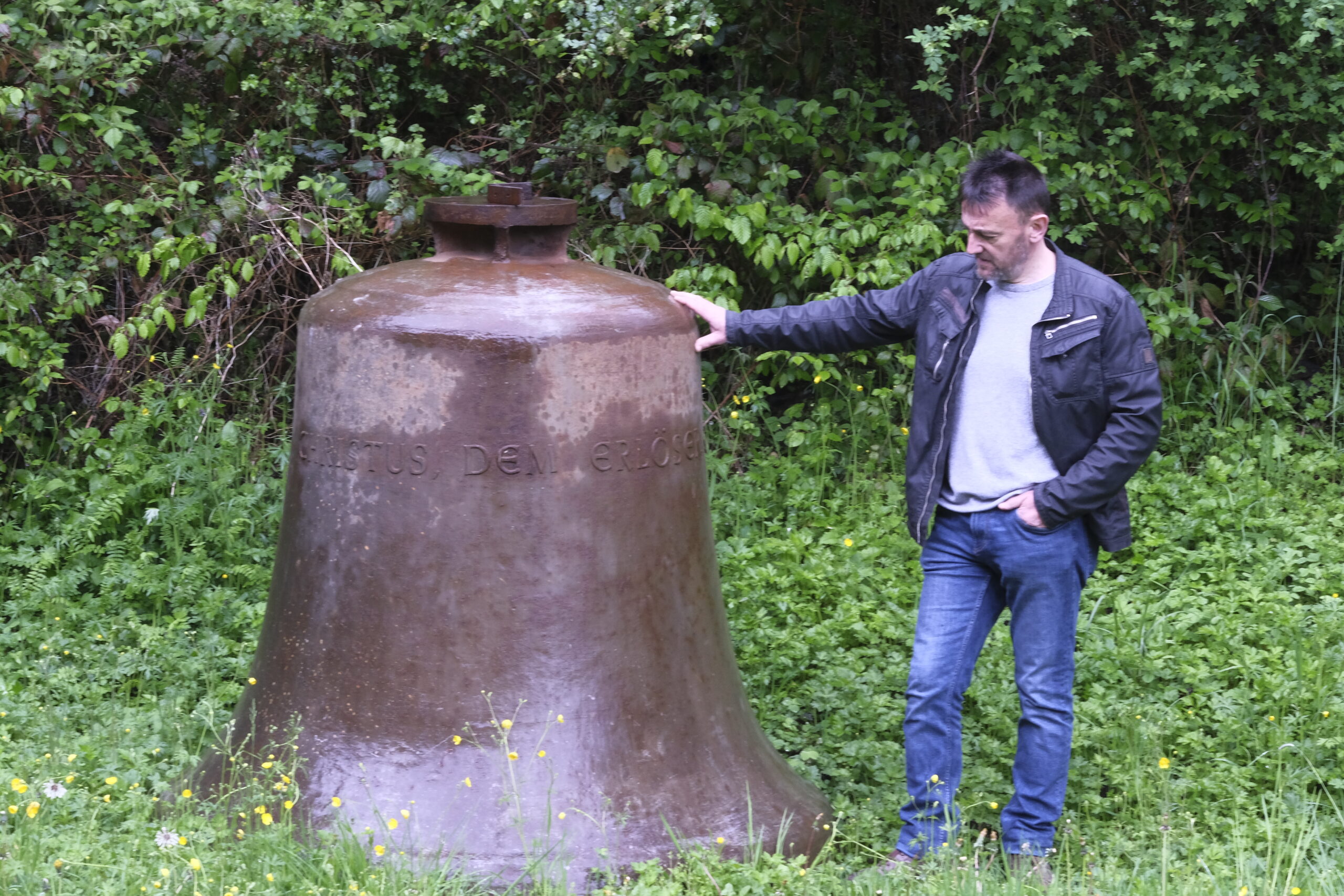
Olivier Baudri with a monumental bell. © Madi’in Europe.
Olivier Baudri started his career in the world of bells in the bell foundry of Tellin, a Belgian village in the region of Wallonia. The trade ran in his family, as his father was also a bell founder. Now he specialises in installation and automation in Belgium and neighbouring countries. In this interview he shares a little bit about his profession as well as what he expects for future generations.
1. Please introduce yourself (profession, area of expertise and years of experience).
I have been a bell maker and bell founder for over 30 years. Now I work in the field of automation of bells and dials in churches.
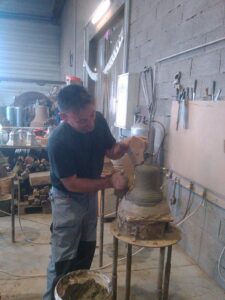
Olivier Baudri at the bell foundry. © Mad’in Europe.
2. What clients/markets do you work with (are they local, national or international)? Which needs does your work generally tackle? Which are the required skills and certifications that your customers request?
We work mainly at the national level, namely in Belgium but we also travel to France and Germany since I frequently work with the company André Voegele. Our field of expertise is quite vast since we touch several trades such as carpentry, mechanics, electricity, clock-making, automation. We also do gold leaf coating. We have an accreditation that allows us to work in the field of heritage.
3. Please briefly explain how your profession is related to religious heritage and/or cultural heritage.
My profession is directly linked to cultural heritage since I am in charge of the maintenance of church bells. We also maintain and restore some castle bells, but this represents a small part of our work.
4. Please describe the main steps of your usual working process and the materials that you use most.
First of all we make an inventory of the bells and their installation. Then we draw up a report of the work to be done for the conservation of the bell. The steps obviously depend on the condition of the installation. We can end up having to redo the bell’s mounting (the element that allows it to stand). This mount is usually made of wood or metal. Another important step is the electrification and automation of the bell. We add motors and automatisms which allow the bell to ring at a precise time.
5. Do you regularly cooperate with craft professionals from other fields? If yes, can you explain which ones and why?
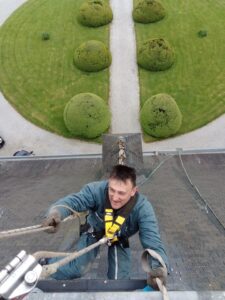
Olivier Baudri climbing the bell tower. © Mad’in Europe.
In my job I regularly collaborate with a clockmaker for all the mechanical parts of the clock, such as the production of the cogs. The rest is almost exclusively made by us.
6. Please mention any innovation that helped improve your work (technological, digital, material related, legal…) and explain the impact they had on your profession.
There have been several innovations in my profession. For example, to create a bell we can now use a 3D printer system that allows us to make symbols on the bells. On the technical level, we can count on more efficient hoists to move the bells inside the bell tower.
There have also been many innovations in the automation of the bells. In the past, the automation systems were mechanical, they were semi-electric-mechanical clocks, but now we have automatons with touch screens and telephone connection systems. So we can switch on the bells from anywhere.
7. How did you learn the profession? Can you detail your learning path mentioning schools and workshops where you were trained?
I got into the business because I live in Tellin. In my family we have been from here from father to son for several generations. The bell foundry in Tellin has always been a landmark in the village, it has always intrigued me. So I started learning the trade in a Flemish company for a few years. Then I went to work in France with Mr. Voegele before becoming independent in 1995.
8. Do you pass on your knowledge to young people? If yes, how? In schools, through workshops…?
I pass on my knowledge to my son who is currently working with me. I try to pass on the trade to him.
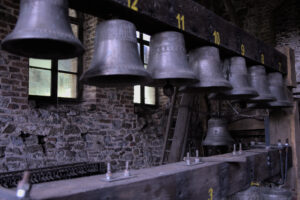
Detail of a carrillon. © Mad’in Europe.
9. What would you recommend to a young person interested in your profession? What are the opportunities and areas in which they can work with your skills?
The job of bell maker is a magical job, every day I discover new places where people don’t go. You climb up beautiful bell towers and see bells that can be over 200-300 years old. Knowing that you will be able to ring them again and preserve them is really a pleasure more than a job for me. That’s why I recommend my job to young people. More than a job, I’m doing something I love.
10. Which are the threats that may endanger your profession? Can you mention some difficulties that are associated with your work? Which could be the solutions to better support your profession and preserve the transmission of skills?
The main threat is the shortage of bellmakers, especially in Belgium. The situation is a bit better in other European countries like France for example, but in Belgium we are very few. In Flanders there is hardly anyone left. This is largely due to the lack of training that we suffer from in the country. Another disadvantage is the time lost in administrative and bureaucratic procedures. This time is therefore not spent in the workshop.
You can find out more about Olivier Baudri’s work on his website.
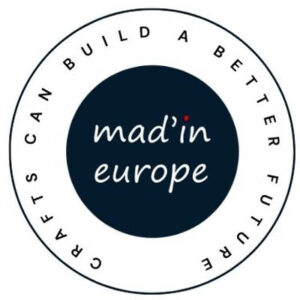 Mad’in Europe (MIE) is a small company committed to promoting craft professionals and crafts professions and to supporting the transmission of crafts skills at a European level. Its multilingual portal gathers a large audience around the profiles of 1,500 crafts, restorers and fine crafts professionals. As a member of some European organizations and thanks to its wide European network MIE participates in several transversal activities including Erasmus and Horizon projects which focus on valorisation of crafts, preservation of traditional know-how, and raising awareness among young people, for whom the sector represents a source of employment.
Mad’in Europe (MIE) is a small company committed to promoting craft professionals and crafts professions and to supporting the transmission of crafts skills at a European level. Its multilingual portal gathers a large audience around the profiles of 1,500 crafts, restorers and fine crafts professionals. As a member of some European organizations and thanks to its wide European network MIE participates in several transversal activities including Erasmus and Horizon projects which focus on valorisation of crafts, preservation of traditional know-how, and raising awareness among young people, for whom the sector represents a source of employment.
 Future for Religious Heritage (FRH) is an independent, non-faith, non-profit European network founded in 2011 and based in Brussels to promote, encourage and support the safeguard, maintenance, conservation, restoration, accessibility and embellishment of historic places of worship. Our network represents more than 80 organisations and over 120 professionals from 36 countries, which includes NGOs, governmental organisations, religious and university departments, and individuals. We are one of the 36 European networks currently supported by the Creative Europe Networks programme.
Future for Religious Heritage (FRH) is an independent, non-faith, non-profit European network founded in 2011 and based in Brussels to promote, encourage and support the safeguard, maintenance, conservation, restoration, accessibility and embellishment of historic places of worship. Our network represents more than 80 organisations and over 120 professionals from 36 countries, which includes NGOs, governmental organisations, religious and university departments, and individuals. We are one of the 36 European networks currently supported by the Creative Europe Networks programme.





Follow us: